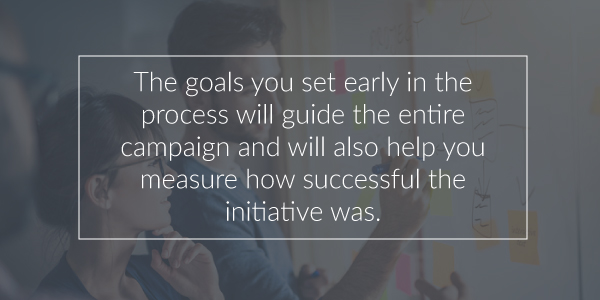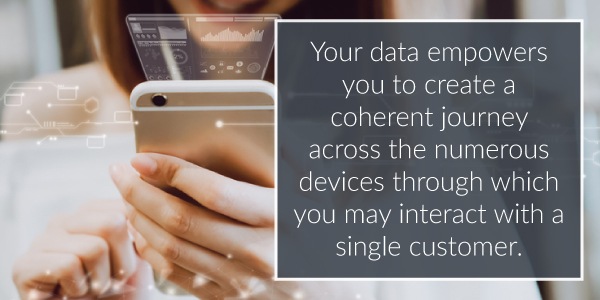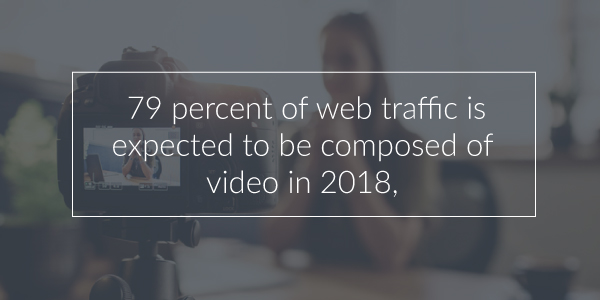You’ve probably heard how important data is for marketing in today’s world. Today, there is more data available to us than ever. The world produces an astounding 2.5 exabytes every day. For that data to be useful, though, you need to have a plan for turning it into insights to improve your marketing campaigns. If you do, you can expect your company’s revenue to increase.
Data-driven marketing campaigns use customer data to optimize performance, by enabling more accurate predictions about customer behavior. By offering enhanced insights into your audience, you can use this data for more precise targeting, personalized customer experiences and improved return on investment (ROI). By understanding who your audience is, and what they are most interested in using this customer data, you can provide them with a better experience and improve your sales.
To store, organize and activate all of this data from multiple sources, you will need a data collaboration platform (DCP). Organization and activation are essential for making use of your data. Without a DCP, you are left with multiple data sets in many different silos. With a DCP, you can see all the data combined for an overall, holistic understanding of your customers across platforms and devices.
So now that you have gathered all this information on your customers, what do you do with it to make sure your marketing campaigns are accurately reaching these customers? To further ensure you get the most out of your data, you need to have a plan in place for doing so. The following is a five-step guide to assist you in creating a successful data-driven marketing campaign.
Step 1: Set a Well-Defined Goal
As with any successful marketing campaign, you first need to define what success means for you. The goals you set early in the process will guide the entire campaign and will also help you measure how successful your initiative was.

Your goals might include boosting sales, increasing brand awareness, driving more website traffic, improving customer satisfaction rates or one of many other potential objectives. You should make sure that the goals you set are “SMART,” which stands for specific, measurable, actionable, relevant and time-bound:
- Specific: Your objective should be specific, not vague. Drill down as far as you can when defining your goals.
- Measurable: You should be able to measure your progress toward your goals. That means defining a specific number for the sales, website traffic, email list subscribers or other things you want to earn. These quantifiable measures are sometimes called key performance indicators, or KPIs.
- Achievable: An ideal goal will challenge you without being impossible. Outline a reasonable path to achieving your target, so you know it’s attainable.
- Relevant: Your goal should support your overall business objectives. This is the “why” of your marketing campaign.
- Time-bound: Set a deadline for achieving your goal as well as benchmarks to measure your progress as you go.
Step 2: Have a Clear Understanding of Your Target Audience
Next, you’ll need to figure out who it is you need to reach to accomplish your objectives. This is your target audience. Since no business can afford to target everyone with its marketing, you need to narrow down your audience to the group of people most likely to take the action you need them to make to bring you closer to your objectives.

For example, what kind of person is most likely to purchase the product or services you’re offering? Knowing who you’re talking to will make the messaging of your campaign more relevant to them. Be as specific as you can when defining your target audience. Describe these people in terms of:
- Demographics: Relevant demographic information could include age, gender, marital status, education level, income level, location and much more. Choose the details that are relevant for your campaign, and go into as much detail as you can. It’s also useful to identify psychographic information for your audience, which includes their interests, values, habits and opinions.
- Behaviors: To get a clearer understanding of your audience as it relates to your campaign, study their behaviors. The behaviors that are of interest to you depend on the goals of your marketing. If you’re looking to boost sales, for example, you might look at your audience’s past purchases. Other useful information includes the type of ads and online content your audience responds best to, their social media activity and more.
- Motivations: You will then seek to understand the motivations of your audience. If you know about their goals, you’ll have a better idea of how you can appeal to them. It enables you to offer them something that empowers them to achieve their goals in a way that also lets you accomplish yours. For example, if you’re a business-to-business (B2B) marketer, your customers’ motivations likely include growing their businesses. Understanding this, you can present the product you’re marketing in a way that highlights its ability to help them get new clients. If you are marketing running shoes, you can appeal to your customers’ desire to be better runners.
Step 3: Line up the Right Data
High-performing data-driven marketing campaigns, of course, will only work with accurate, relevant data. To get this data, you can start with information you’ve collected about past customers, such as:
- Sales histories – what products are they buying most
- Customer service communications
- Actions visitors took on your website
- Completed customer surveys
All of this data you gather on your customers is called first-party data. But what if you don’t have enough information and are looking for more insights about these loyal customers? There are options for supplementing your existing first-party data. To expand the data you have access to, you can buy third-party data from large aggregators through exchanges (such as the Lotame Data Exchange). Alternatively, if you don’t want to buy and sell data on the open market, you can look to second-party data, which relies on private marketplaces and a 1:1 data collaboration between two companies.
Once you organize all of this data in a DCP, you can much more easily define your target audience.
Make sure you have a clear picture of what you need these people to do to help you achieve your goals. Do you need them to make a purchase? Visit your website? Follow you on social media? Next, create a plan for how you will encourage them to take the desired action.
Creating this plan will involve optimizing the customer journey, which includes every interaction someone has with your brand from the first time they hear about it to their decision to make a purchase and all of the communication in between, as well as the interactions you have with them after the initial buy. Journey optimization involves outlining these interactions so you can play a more active role in determining what the customer’s experience with your brand is like.
It also enables you to direct them to the action you want them to take. The journey optimization approach encourages brand loyalty because it allows you to personalize the experience to individual consumers.

Data, organized within a DCP, is crucial to this customer journey optimization. It enables you to collect and manage all of your interactions with customers from various sources, including both online and offline ones. Your data also empowers you to create a coherent journey across the numerous devices through which you may interact with a single customer. Lotame can assist with this journey optimization. Our services give you the ability to retarget, reach people across screens and unify your data.
Step 4: Select Your Marketing Channels
Next, you’ll need to choose which marketing channels you want to run your campaign on. Examples of channels you could consider include social media sites, your company’s blog, pay-per-click ads, email, television commercials, radio commercials, magazine ads and billboards. Of course, there are many more options as well. Rather than choosing a vague description like “social media” or “newspapers,” identify a specific social platform or publication.
The best indicator of where you should conduct your campaign is your target audience’s behaviors. Go where your customers are. Dig into your data and find out what kinds of media they use and the places where they are most likely to respond well to your marketing content. Data will give you a place to start, but you’ll fine-tune your strategy as you go.
Also, consider the strengths and weaknesses of each channel. Instagram, for example, is ideal for visual content but less so for text-heavy content. Billboards enable you to reach a broad audience, but they don’t let you target who sees your ad. Budget and the talent you have available to create content will factor in as well.
Once you’ve evaluated all potential channels with regard to your audience’s behaviors as well as their benefits and drawbacks, choose a few to use that will likely be the most effective for accomplishing your goals. While omnichannel campaigns can be valuable, be careful not to spread yourself too thin, as this can reduce the potency of your strategy. You can always add in more channels at a later point.
That said, you should be sure you coordinate the messages you’ll use across all of the channels you do choose. You should be able to stay aligned with the customer journey, no matter what channel or device the customer is interacting with your brand on, rather than sending them repetitive messaging. This approach will keep your messaging consistent and reach customers when and where they’re ready to engage or make a purchase.
Step 5: Serve Appropriate Content
Next, it’s time to design your marketing content and distribute it across channels, each one of which should point your audience toward your ultimate goal. Many different factors go into deciding what type of elements you will use and what exactly that content will consist of.
1. Audience
One factor is, again, the preferences of your audience. Do they react better to videos or blog posts? How long do they like content to be? Today, video content is especially popular, with 79 percent of web traffic expected to be composed of video in 2018, but you should customize your content strategy according to your audience’s preferences. Your audience data will guide you through these decisions.

2. Your Goals
The objectives of your campaign may also influence the type of content you create. An infographic, for instance, may suffice for explaining a relatively simple concept. For more in-depth information, though, you might need to create a video, blog post or even an e-book.
3. Channels Used
The channels you chose for your campaign will also, to some extent, impact the type of content that works best for you. Some media, such as Instagram or billboards, is ideal for images. Others require a greater emphasis on text. Optimize your content for each channel by relying on data, looking into the types of content that perform best there. Although you want to customize your content for the place it appears, it should still form a cohesive cross-channel campaign, using the same keywords and phrasing.
4. Customer Journey
You will also have to personalize your messaging for where the customer is in their buying journey. The copy you use when introducing someone to your brand will be different than what you use to close a sale. Optimizing your content for the customer’s point on their journey will encourage them to move to the next step on their path toward becoming a loyal customer. Remember, though, that it usually takes numerous encounters before a consumer will act on your messaging, so patience is critical. Trying to move them forward before they’re ready can be detrimental.
One of these variables cannot determine your ideal marketing content on its own. Finding the perfect piece of messaging requires combining these four factors to create a solution optimized for your audience, your goals, the channels you use and where each customer is in their journey. Doing so enables content customization for each customer interaction. This personalization requires a firm grasp of your marketing data, another area where Lotame can assist you.
Step 6: Track Your Campaigns
A successful data-driven marketing strategy requires continuously collecting data throughout your campaigns. As your campaign proceeds, you can use the performance metrics you identified earlier to keep track of your progress so that you can figure out what is working well and what is not.
You should keep track of and regularly analyze how often your audience has completed the desired actions. Technology like our analytics tool within the Lotame Spherical Platform can track your campaign performance. It provides you with a clearer view of the behavior attributes present in customer interactions and how those attributes impact the success of your marketing efforts.
Armed with these insights, you can refine your target audience, make your campaign more efficient by eliminating ad waste and identify patterns in high-performing content to optimize your overall content strategy. Insights can even reveal new audiences that are similar to your current one to enable you to expand your reach.
Crucially, you should continually monitor and refine your campaign as it progresses. This will aid you in achieving your objectives more quickly and reliably, and may also improve the performance of future marketing efforts. Over time, your marketing team will begin to function like a well-oiled machine, while continuously improving.
Let Lotame Assist You With a Data-Driven Marketing Campaign
Lotame’s Spherical platform is the be-all end-all in data collaboration. Spherical empowers thousands of marketers, agencies, and media owners to onboard, access, analyze, and activate the data they need to understand and engage consumers. Our solutions can help you run successful data-driven marketing campaigns, while making smarter, faster and easier decisions with your data. Get Data Empowered with Lotame.
Want to see how our technology works and learn more about how it can optimize your marketing? Fill out the form below to contact us today to request a demo!